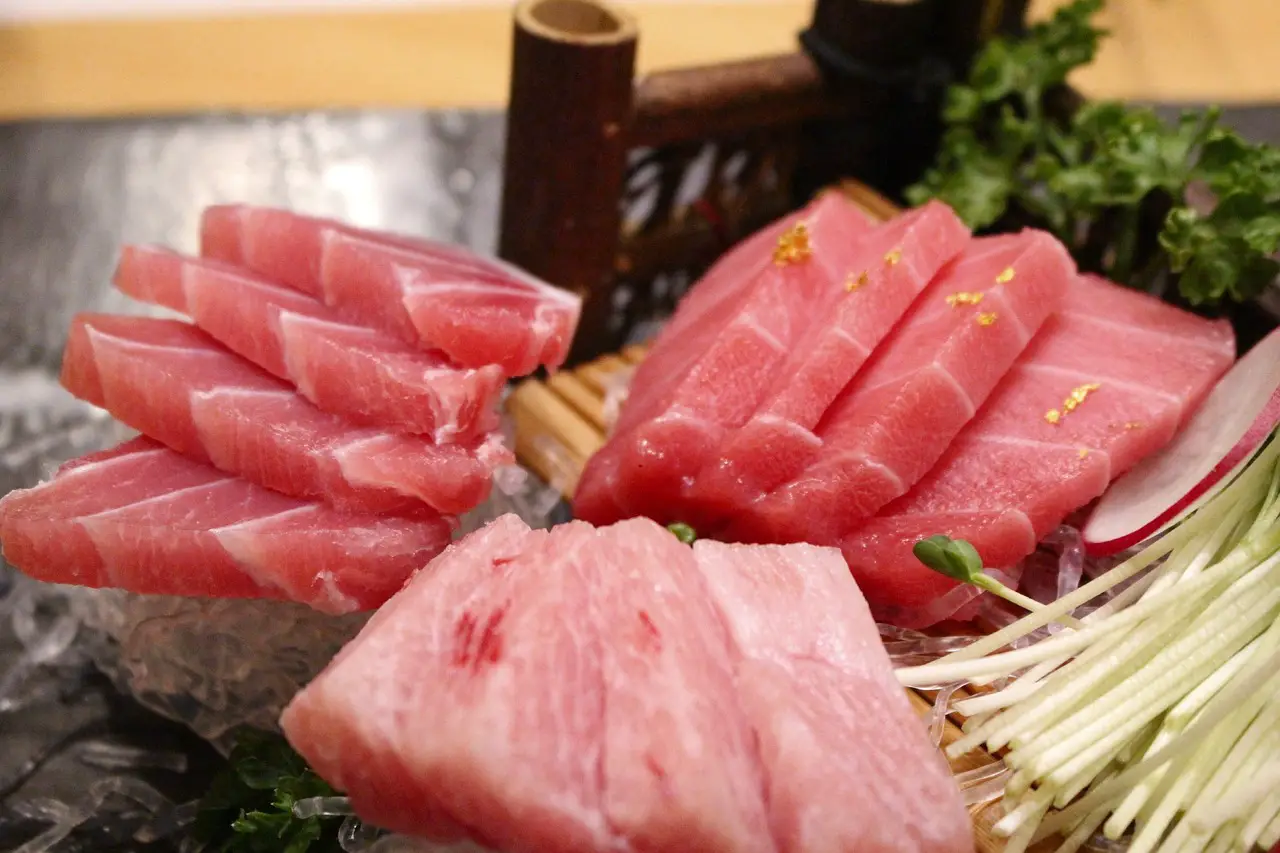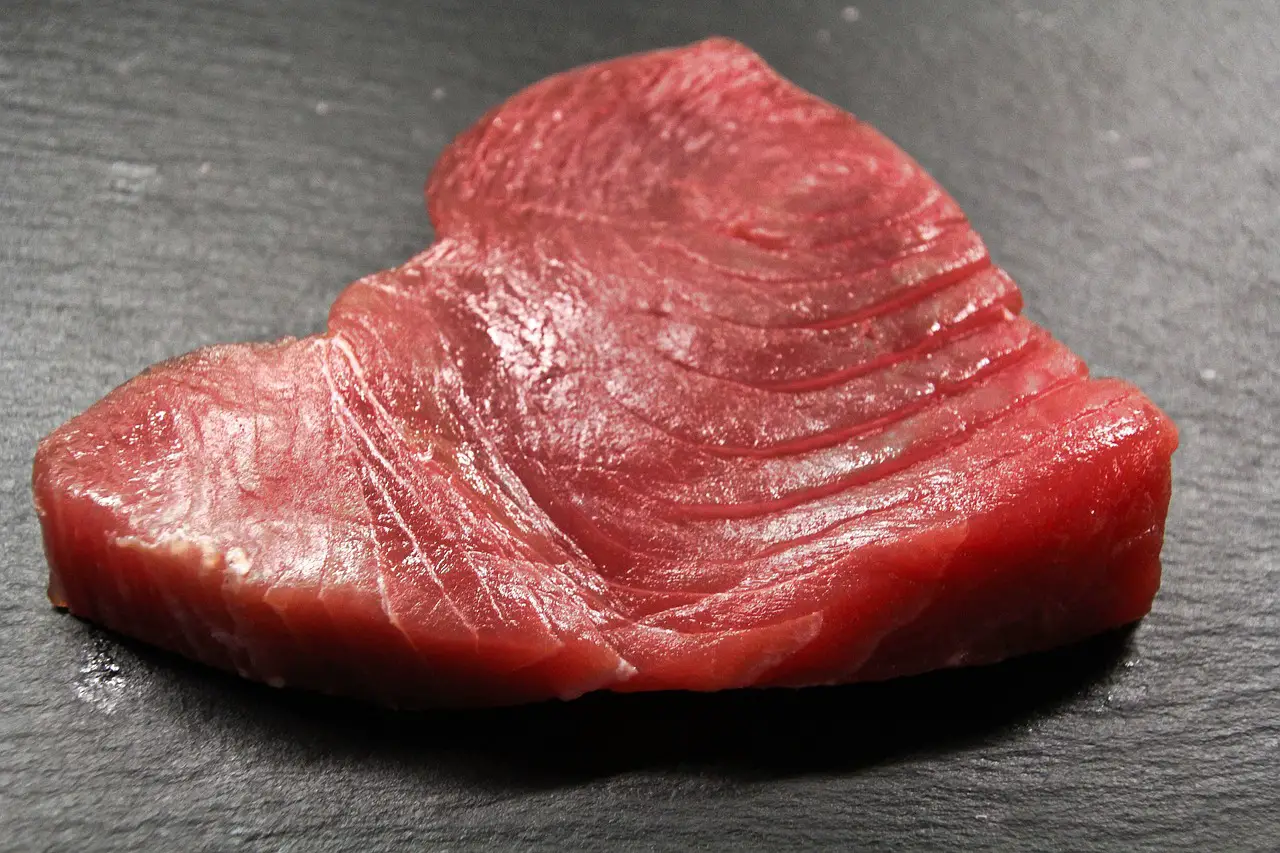If you want to enjoy your favorite tuna steaks but are unsure how to defrost them, then you are in luck. With a simple method of thawing, you can have your delicious fish ready to cook in no time. If you want to defrost your tuna steak, you mustn’t use warm water. It is best to thaw it in cold water. You can also melt it overnight in the refrigerator.
The proper defrosting technique for frozen tuna steaks is essential for a healthy meal. It helps preserve the texture and flavor of your fish. Using a refrigerator or a bowl filled with cold water, you can safely thaw your tuna. To start, remove the vacuum pack from the frozen fish. If the fish is vacuum sealed, a quick rinse will help to remove the ice crystals and bacteria.

What are Tuna Steaks?
A cut of tuna fish known as a “tuna steak” is normally taken from the fish’s loin. It is a kind of fish ideal for eating raw because it is of the sashimi grade. Typically cut into large, boneless portions, tuna steaks can be grilled, seared, or served plain in dishes like sushi and sashimi. Many cultures enjoy tuna steak because of its rich, sweet flavor and hard texture. Protein, omega-3 fatty acids, and vitamins like vitamin D and B12 are all abundant in them.
How to Defrost Tuna Steaks?
A tuna steak can be defrosted in various methods, such as:
- The safest way to defrost tuna steaks is in the refrigerator. Arrange the steaks in a dish and wrap them in foil or plastic. They should spend at least 24 hours overnight defrosting in the fridge.
- The steaks should be placed in a sealable plastic bag and in cold water to defrost. To ensure that the fish thaws evenly, change the water every 30 minutes. It should take between 30 and 1 hour to complete this procedure.
- The tuna steak may start to cook and lose its texture if you microwave the frozen food to thaw it. If you must use this method, turn the microwave to the defrost setting and put the steak in a microwave-safe dish. Be careful to cook the steak immediately after it has thawed, and keep a close eye on it.
Whatever the approach, it’s critical to cook the tuna steak right away once it has thawed to maintain food safety.
How to Properly Freeze Tuna Steaks?
There are a variety of techniques for freezing tuna steaks. However, the following can help you maintain the fish’s quality:
- The steaks should be wrapped in plastic or aluminum foil with as little air as possible.
- Put the wrapped steaks in a freezer bag that can be sealed, and write the date and type of fish on the bag.
- Put the bag in the freezer’s coldest section, ideally at or below 0 degrees.
- The freezer has a six-month shelf life for a tuna steak.
It’s vital to remember that after being frozen and thawed, the texture and quality of the tuna steak may alter. Eating the tuna within three months of freezing is preferable to help maintain its quality. Additionally, when defrosting the tuna steaks, use a technique that keeps the fish’s quality as high as possible, like refrigerator thawing.
How to Store Tuna Steaks?
Tuna steaks should be kept fresh and prepared for consumption. The following advice is for keeping tuna steaks:
- Tuna steaks should be stored in the fridge until needed. The recommended temperature for tuna steaks is 40°F or lower.
- The tuna steaks should be kept in the refrigerator in their original packaging, plastic wrap, or aluminum foil if you intend to consume them within two days.
- When storing tuna steaks in the refrigerator, it’s a good idea to vacuum-seal, wrap them in plastic or aluminum foil, or both if you want to use them within a week.
- The best choice is to freeze the tuna steaks if you intend to utilize them more than a week from now. The steaks should be wrapped in plastic or aluminum foil before being placed in a freezer bag that can be sealed. The freezer bag should be labeled with the date and the type of fish.
- To maintain freshness and safety, tuna steaks should be eaten or frozen within two days of purchase.
It’s vital to remember that after being frozen and thawed, the texture and quality of the tuna steak may alter. Eating the tuna within three months of freezing is preferable to help maintain its quality.
What are the Techniques for Cooking Tuna Steaks?
Tuna steaks can be prepared in a variety of ways, including:
- Cooking tuna steaks on the grill is a common practice. Grill the steaks over high heat while preheating them to avoid sticking. For medium-rare, grill the steaks on each side for two to three minutes. If you want your tuna more well-done, examine them longer.
- Another well-liked technique for preparing tuna steaks is searing. A little oil is added to a heavy skillet heated over high heat. For medium-rare, place the steaks in the skillet and sear for 1–2 minutes on each side. If you prefer your tuna more well-done, sear the steaks for longer.
- Tuna steaks can be grilled by placing them on a broiler pan and roasting them in the oven. For medium-rare, broil the steaks on each side for two to three minutes. If you want your tuna more well-done, broil them longer.
- Cooking tuna steaks in a pan is a quick and easy process. A skillet with a little oil in it should be heated to medium-high heat. For medium-rare, place the steaks in the skillet and cook on each side for two to three minutes. If you prefer your tuna more well-done, cook the steaks for longer.
- Tuna steak can be consumed raw, thinly sliced, and is frequently accompanied by soy sauce and wasabi in sushi or sashimi.
It’s crucial to remember that tuna steak is a “sashimi-grade” fish, which means it is acceptable to eat raw. Nevertheless, it is always advised to cook tuna steak until the internal temperature reaches at least 145°F to ensure safety.
From Where to Buy Fresh Tuna Steaks?
There are several places where you may get tuna steaks, including:
- Supermarket stores: Tuna steaks can be purchased in the seafood area of most grocery stores and are either fresh or frozen.
- Seafood markets: Tuna steaks can also be purchased at nearby seafood markets. Tuna steaks are typically among the many fresh fish and seafood options they carry.
- Online merchants: Frozen tuna steaks are offered by several online merchants, including Amazon and FreshDirect, and can be delivered right to your door.
- Specialist shops: A few specialty shops, like Whole Foods or Trader Joe’s, sell fresh tuna steaks and tuna fit for sashimi.
- Fishmongers: Fishmongers are knowledgeable about fish and seafood and can provide you with a wide range of selections and helpful guidance on choosing and preparing your tuna steak.
It’s crucial to look for fresh, high-quality fish when purchasing tuna steaks. Look for steaks with a bright, juicy appearance and no brown or discolored patches while buying in-store. If purchasing frozen, check if the steaks are well-wrapped and the packaging is in good condition.
How to Identify Tuna Steaks are Gone Bad?
A bad tuna steak can be identified in several ways:
- Smell: A pleasant, oceanic aroma should be present in fresh tuna. The tuna can be ruined if it has a strong, fishy odor.
- A bright, wet appearance is what you should expect from fresh tuna. The tuna can be rotten if it contains brown or discolored patches.
- Fresh tuna shouldn’t be slimy or sticky and should feel solid. The tuna can be rotten if it is mushy or sticky.
- Bloodline: The color of tuna should be red; if it is brownish or greyish, it has spoiled.
- Date of expiration: Always check the expiration date before buying or consuming any product, as doing so can result in food poisoning or other health issues.
Remember that it’s preferable to err on caution and avoid eating tuna that looks or smells rotten. It is better to throw away a tuna steak if you are doubtful about its freshness. If you think you may have eaten spoiled tuna, keep an eye out for symptoms like nausea, vomiting, and diarrhea. If you have any of these, visit a doctor right away.
What are the Side Effects of Consuming Spoiled Tuna Steaks?
Food poisoning can be brought on by consuming rotten tuna steaks and can manifest as a variety of symptoms, including:
- Consuming rotten tuna may make you feel queasy and uncomfortable in your stomach.
- Vomiting: Consuming rotten tuna might result in nausea and an upset stomach.
- Consuming damaged tuna can result in diarrhea, making you thirsty and dehydrated.
- Constipation: Consuming rotten tuna might result in cramps and soreness in the abdomen.
- Headaches: Consuming rotten tuna may leave you feeling worn out.
- Fever is an infection symptom and can be brought on by eating rotten tuna.
- Consuming rotten tuna may result in allergic symptoms such as rashes, itching, and breathing difficulties.
- Consuming rotten tuna can result in food poisoning, which can be hazardous for those with compromised immune systems.
You must get medical help immediately if you think you may have eaten spoiled tuna. It’s preferable to be safe than sorry because symptoms could manifest within a few hours or over a few days and be quite severe.
The quality of yellowfin tuna fillets, as evaluated by microbiological evaluation, formation of various biogenic amines, and sensory analysis, was studied after storage at 0,4,10 and 22°C for 0,1,3,5 and 9 d. Tuna fillets kept at 22 °C for three days, ten °C for five days, and four °C for nine days were deemed unfit for human consumption. They contained 832 ppm of histamine, 35.8 ppm of putrescine, and 147 ppm of cadaverine in addition to a total aerobic bacterial count of > 8 log10 CFU/g and a bacterial population that produces histamine at a rate of 7 log10 CFU/g. A comparison of the AOAC fluorometric method, gas chromatography, and capillary electrophoresis revealed an excellent correlation (r2 > 0.99) between these three methods for measuring histamine.
Conclusion
The proper thawing technique is the easiest way to ensure you get the most out of your seafood. Thawing it at a constant cool temperature will prevent mushy, waterlogged textures. Another good idea is to double-wrap your tuna in a sheet of cling wrap to ensure no air can enter. This can prevent freezer burn and keep the fish fresh and crisp.
A microwave can also be a useful tool when thawing frozen tuna. Some models have a “smart” defrosting setting. However, this method will likely not defrost your fish as quickly as you would like. Next, add salt and pepper. Make sure that the tuna is covered evenly. Finally, sprinkle a little olive oil on top.
